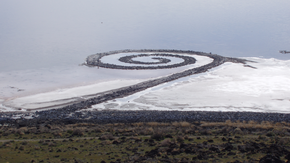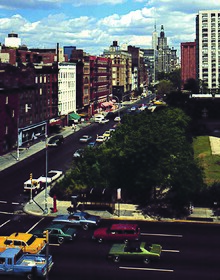

Land art, variously known as Earth art, environmental art, and Earthworks, is an art movement that emerged in the 1960s and 1970s,[1] largely associated with Great Britain and the United States[2][3][4] but that also includes examples from many countries. As a trend, "land art" expanded boundaries of art by the materials used and the siting of the works. The materials used were often the materials of the Earth, including the soil, rocks, vegetation, and water found on-site, and the sites of the works were often distant from population centers. Though sometimes fairly inaccessible, photo documentation was commonly brought back to the urban art gallery.[3][5][6]
Concerns of the art movement centered around rejection of the commercialization of art-making and enthusiasm with an emergent ecological movement. The art movement coincided with the popularity of the rejection of urban living and its counterpart, an enthusiasm for that which is rural. Included in these inclinations were spiritual yearnings concerning the planet Earth as home to humanity.[7][8]
- ^ "Land art – Art Term". Tate.
- ^ Kastner, Jeffrey (June 23, 2010). Land and Environmental Art. Phaidon Press. p. 14. ISBN 9780714856438 – via Google Books.
- ^ a b Art in the modern era: A guide to styles, schools, & movements. Abrams, 2002. (U.S. edition of Styles, Schools and Movements, by Amy Dempsey) ISBN 978-0810941724
- ^ "Earth Art Movement Overview". The Art Story.
- ^ http://mymodernmet.com Unexpected Land Art Beautifully Formed in Nature.
- ^ http://www.land-arts.com Land art.
- ^ ArtSpeak, A Guide to Contemporary Ideas, Movements, and Buzzwords, 1945 to the Present, By Robert Atkins, Abbeville Press, 2013, ISBN 978-0-78921-150-7
- ^ "Land Art: Earthworks that Defined Postwar American Art". Art & Antiques Magazine. April 4, 2012. Archived from the original on March 27, 2018. Retrieved June 22, 2017.